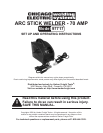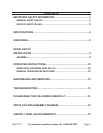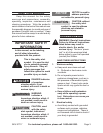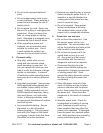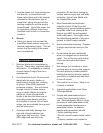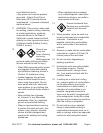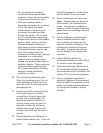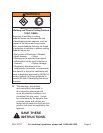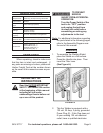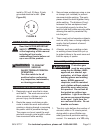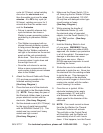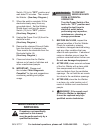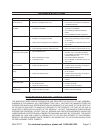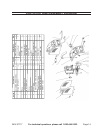Page 7SKU 97717 For technical questions, please call 1-800-444-3353.
Do not dispose of hot slag in •
containers holding combustible
materials. Keep a re extinguisher
nearby and know how to use it.
After spot welding, make a •
thorough examination for evidence
of re. Be aware that easily-
visible smoke or ame may not
be present for some time after
the re has started. Do not weld
or cut in atmospheres containing
dangerously reactive or ammable
gases, vapors, liquids, and dust.
Provide adequate ventilation in
work areas to prevent accumulation
of ammable gases, vapors, and
dust. Do not apply heat to a
container that has held an unknown
substance or a combustible
material whose contents, when
heated, can produce ammable or
explosive vapors. Clean and purge
containers before applying heat.
Vent closed containers, including
castings, before preheating,
welding, or cutting.
Do not touch live electrical parts. 20.
Wear dry, insulating gloves. Do not
touch electrode or conductor tong
with bare hand. Do not wear wet or
damaged gloves.
Protect yourself from electric shock. 21.
Do not use outdoors. Insulate
yourself from the work piece and
ground. Use nonammable, dry
insulating material if possible, or
use dry rubber mats, dry wood or
plywood, or other dry insulating
material big enough to cover your
full area of contact with the work or
ground.
Ensure that the unit is placed on a 22.
stable location before use. If this unit
falls while plugged in, severe injury,
electric shock, or re may result.
Avoid overexposure to fumes and 23.
gases. Always keep your head out
of the fumes. Do not breathe the
fumes. Use enough ventilation or
exhaust, or both, to keep fumes and
gases from your breathing zone and
general area.
Where ventilation is questionable, 24.
have a qualied technician take
an air sampling to determine the
need for corrective measures. Use
mechanical ventilation to improve
air quality. If engineering controls
are not feasible, use an approved
respirator.
Follow OSHA guidelines for 25.
Permissible Exposure Limits (PEL’s)
for various fumes and gases.
Follow the American Conference of 26.
Governmental Industrial Hygienists
recommendations for Threshold Limit
Values (TLV’s) for fumes and gases.
Have a recognized specialist in 27.
Industrial Hygiene or Environmental
Services check the operation and air
quality and make recommendations
for the specic welding or cutting
situation.



